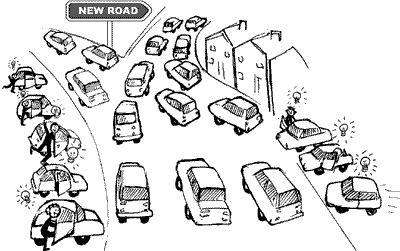Suppressed Demand

1.Many would-be drivers are put off by congestion and the difficulty in finding places to park.
|

2.Building a new road (or widening an existing one) creates more space to drive in.
|

3.The space fills with more would-be drivers and congestion quickly reaches the same level as before(1).
|
This effect has confounded many anti-congestion efforts, particularly 'soft' demand management measures such as travel plans for company
employees or increasing public transport provision(2). There are simply too many would-be drivers. Road pricing,
on the other hand, is demand management proper - it deters people from wanting to drive. But even so, it is not enough on its own.
The mirror image of this effect also occurs. When roads are removed or become too congested, many drivers simply decide not to drive. This
effect has been called 'Traffic Evaporation'(3), and it was famously observed during the closure of Lendal Bridge
for a month in the late seventies, which utterly failed to bring the city to the predicted standstill.
Notes and References
1.
The effect, also known as 'Traffic Induction' has been observed and written about widely. See, for example "New roads generate new traffic"
(R.H.H. Pfleiderer and M Dieterich, in World Transport Policy and Practice,
Vol.1 No.1, pgs. 29-31). Perhaps the most definitive study is Trunk roads and the generation of traffic (Standing
Advisory Committee on Trunk Road Assessment, 1994), available from
The
Stationery Office, though perhaps the most damning is the report on traffic generation at the infamous Newbury bypass - the scene of the massive
direct action and tree occupation protests from 1994-8. A 2006 study revealed that
traffic through the town centre had risen by 10% since the opening of the bypass, with attendant increases in accidents and congestion. (Reported
January 2006 by Friends of the Earth and
September 2006 by the CPRE).
2.
Soft measures are of course more sellable to the general (mostly driving) public, and so continue to receive most political attention - and
therefore significant academic attention. A research project 'The influence of soft factor interventions on travel demand' was carried out by
a team of transport economic heavyweights including Sally Cairns and Phil Goodwin. Their final report shows a variety of achievements of 'soft'
measures - inclusing from York. The conclusion, crudely characterised, is that soft measures can reduce car use in a particular
population, but if any improvement is to be made, underlying policy must prevent the release of induced traffic. In other words, 'soft' measures
sweeten the necessary pill of real demand management. In their words: "we have adopted the assumption that sufficient supportive measures
will be put in place not to obscure the impacts of soft factors". Read their report:
Smarter Choices - Changing the Way We Travel
(Cairns, Sloman, Newson, Anable, Kirkbride and Goodwin, 2004)
3.
This effect was most famously supported and promoted in the study Traffic Impact of Highway Capacity Reductions; Assessment of the Evidence (Cairns, Hass-Klau and Goodwin, 1998) - available from Landor Publishing for £35. You can read a synopsis or a shorter summary report on-line. The article Disappearing traffic? The story so far (Cairns, Atkins and Goodwin, in Municipal Engineer 151 Issue 1) is also worth reading.
|



